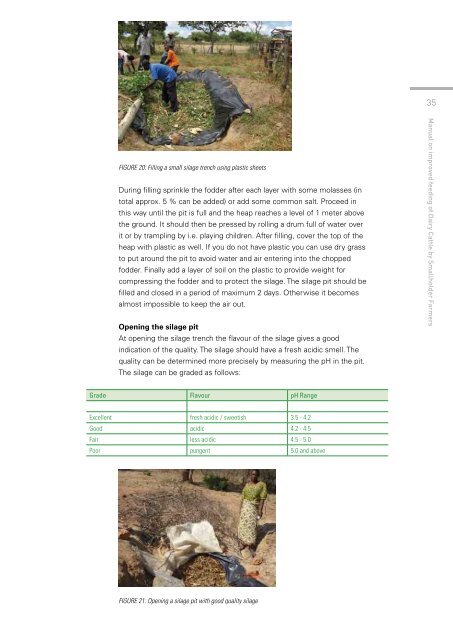MANUAL ON IMPROVED FEEDING OF DAIRY CATTLE BY ... - Gart
MANUAL ON IMPROVED FEEDING OF DAIRY CATTLE BY ... - Gart
MANUAL ON IMPROVED FEEDING OF DAIRY CATTLE BY ... - Gart
Create successful ePaper yourself
Turn your PDF publications into a flip-book with our unique Google optimized e-Paper software.
FIGURE 20: Filling a small silage trench using plastic sheets<br />
During filling sprinkle the fodder after each layer with some molasses (in<br />
total approx. 5 % can be added) or add some common salt. Proceed in<br />
this way until the pit is full and the heap reaches a level of 1 meter above<br />
the ground. It should then be pressed by rolling a drum full of water over<br />
it or by trampling by i.e. playing children. After filling, cover the top of the<br />
heap with plastic as well. If you do not have plastic you can use dry grass<br />
to put around the pit to avoid water and air entering into the chopped<br />
fodder. Finally add a layer of soil on the plastic to provide weight for<br />
compressing the fodder and to protect the silage. The silage pit should be<br />
filled and closed in a period of maximum 2 days. Otherwise it becomes<br />
almost impossible to keep the air out.<br />
Opening the silage pit<br />
At opening the silage trench the flavour of the silage gives a good<br />
indication of the quality. The silage should have a fresh acidic smell. The<br />
quality can be determined more precisely by measuring the pH in the pit.<br />
The silage can be graded as follows:<br />
Grade Flavour pH Range<br />
Excellent fresh acidic / sweetish 3.5 - 4.2<br />
Good acidic 4.2 - 4.5<br />
Fair less acidic 4.5 - 5.0<br />
Poor pungent 5.0 and above<br />
FIGURE 21: Opening a silage pit with good quality silage<br />
35<br />
Manual on improved feeding of Dairy Cattle by Smallholder Farmers


